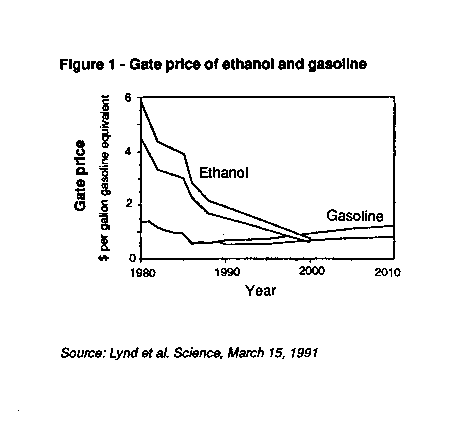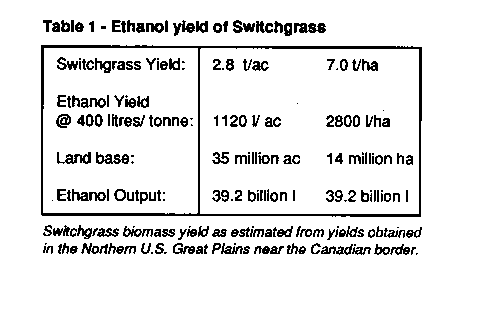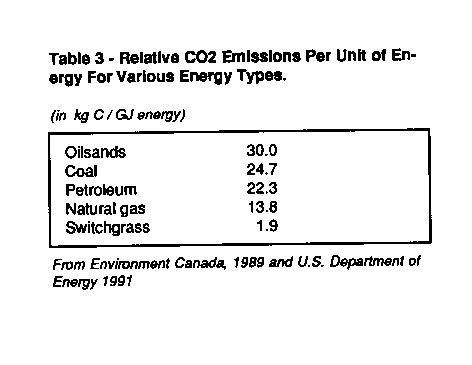
A grandiose scheme is proposed to replant 35 million acres of tallgrass prairie to be used for ethanol. It would: replace all of Canada's gasoline requirements; reduce government subsidies to both the agriculture and energy sectors; not only save farms but create rural employment opportunities; prevent Canada from becoming a net oil importing nation; rehabilitate prairie soils and wildlife populations; and reduce Canadian CO2 emissions by 15%. It sounds all too good to be true; can it be?
by Roger Samson
Since Ford introduced the mass produced automobile, people have tinkered with making ethanol out of everything, from corn to milkweed. The principal problem has been that too much energy is used to grow, harvest and process the raw material. When all is said and done, the ethanol industry uses about as much energy as it provides. Not only is it energy inefficient, but if energy prices escalate, so does the cost of the ethanol because its' production costs are associated with fossil fuel prices. Crops which have been bred for use as food for humans or animals may not necessarily be the most efficient when it comes to using them as energy crops because the fossil fuel dependency is never broken.
In 1985, the U.S Department of Energy (DOE) began a five year screening program to develop a low cost, herbaceous crop program. They screened the potential of traditional and non-traditional, annual and perennial, crop plants for their capacity in producing moderate to high biomass yields at low cost. The goal of the DOE Herbaceous Energy Crop Program was to produce competitively priced liquid fuels from biomass, with an emphasis on utilizing marginal lands that were limited agriculturally by erosion, wetness or other soil factors.
In 1991, switchgrass, a warm season perennial grass, was chosen as the model herbaceous crop species. This was done not with the assumption that switchgrass will be the only crop for biofuel development, rather that it is very promising species which provides an opportunity to focus available resources for development of the industry.
Switchgrass is not widely known in Canada despite the fact that it is a native species found in Ontario, Quebec and on the prairies in Manitoba and Saskatchewan. It's main use presently is centred in the U.S. Midwest and plain states, where it is used for midsummer forage production. Switchgrass was of considerable economic importance during the period of settlement in Manitoba, but the extensive stands of naturally-present switchgrass were reduced by overgrazing and the plowing-up of the native sod.
Several research reports from the U.S. have calculated switchgrass production costs to be less than $30.00 per tonne, this using cultivars that were mainly developed in the 1950s. With a breeding program aimed at maximizing biomass yields, rather than forage quality, even lower production costs could be realized. With a projected market value of $35.00-40.00 per tonne for cellulosic conversion, there is significant potential for a viable industry. Compare this with the Canadian wheat industry, with a market price of approximately $2.00 per bushel and costs of production at $4.50-5.00 per bushel. In addition, there is $1.00 per bushel in government subsidies for freight assistance to move wheat out of the Prairies.
The Western grain industry is neither economically nor ecologically viable in its present form. Soil degradation on the Prairies was recently cited in Scientific American as one of the world's four worst examples of soil degradation. One option that the federal government is looking at to deal with the problem is land set aside. The National Soil Conservation Program would be used as a means to retire the most marginal farm land from production. A similar program called the Conservation Reserve Program already exists in the U.S. A recent economic analysis has indicated that it is a less expensive option to put land into switchgrass biomass energy production than into the Conservation Reserve Program, while at the same time achieving similar erosion control goals.
While biomass feedstock production technologies have been improving, even more dramatic has been the improvement in ethanol conversion technologies for cellulosic biomass. This was the subject of a major article in the journal, Science. It shows that a cost competitive process with gasoline is forecast to occur by the end of the decade and that the cost has been dropping rapidly with new advancements in biomass conversion.

One of the best kept secrets in Canada is that the nation is running out of oil. Oil imports will reach $5.5 billion by mid-decade. New Canadian oil projects are also proving very expensive for the amount of oil they extract, much of which is heavy oil requiring considerable processing before marketing. The result is that although biomass ethanol may not be competitive with world oil prices at the moment, it most likely is a less expensive option than new Canadian oil developments such as Hibernia.
Potentially 35 million acres of land currently in summerfallow and surplus grain production could be made available for the development of an ethanol industry based on tallgrass species such as switchgrass. This would be made up of the 20 million acres currently in summerfallow in Western Canada, and 15 million acres currently in spring cereals. This would represent a 30% reduction in cereal acreage in Canada, with the most marginal cereal growing areas being targeted first.

Current Canadian gasoline consumption is approximately 30 billion litres per year, which would require approximately 37.5 billion litres of ethanol for substitution (Techtrol Ltd. of Montreal calculates that one litre of gas can be replaced by 1.25 litres of ethanol).
A switchgrass-based ethanol industry of this size could entirely replace Canada's gasoline requirements, as well as help Canada take a considerable step towards reaching CO2 reduction goals. Switchgrass not only requires lower energy inputs for growing, but also requires few energy inputs for ethanol conversion. The steam and electricity used to convert the switchgrass to ethanol can be derived from the combustion of the lignin (approximately 7% by composition) leftover after the ethanol extraction process. This represents a major difference compared to the grain ethanol industry, which requires large energy inputs from fossil or nuclear energy sources for its conversion.
As a renewable biomass source of energy, switchgrass has tremendous potential to reduce CO2 emissions relative to other energy sources (Table 3). CO2 emissions from the production and combustion of gasoline are approximately 2.5 kg CO2 per litre or 75 million tonnes of CO2 from the 30 billion litres of gasoline consumed in Canada annually. Assuming ethanol derived from switchgrass yields 10% the carbon of gasoline (due to the carbon associated with energy inputs in growing and transporting the switchgrass), it would release 7.5 million tonnes of CO2. The resulting net annual reduction to Canadian CO2 emissions from a switchgrass based ethanol industry would be approximately 15% (with current Canadian CO2 emissions of approximately 450 million tonnes). As well, the change in land use from summerfallow and wheat, to perennial switchgrass, would store an additional 810 million tonnes of CO2. This would come from increased carbon storage in above and below ground vegetation (270 million tonnes), and restoration of soil organic matter levels (540 million tonnes).

Summary of Why Switchgrass is a Low CO2 loading Ethanol Feedstock
1. Possesses a high energy output/ input ratio
2. Ties up CO2 by increasing soil organic matter (which contains 58% C)
3. Increases carbon stored in vegetation both above and below ground relative to present land use (summerfallow and annual grains)
4. Energy for conversion is provided by burning of lignin leftover after the ethanol extraction (rather than using fossil fuels)
An ethanol industry based on biomass, producing 40 billion litres annually, could be established by building four hundred ethanol plants, each one with a capacity of 100 million litres. This would provide thousands of jobs to some of the most disadvantaged areas in Canada. It would greatly stimulate the farm economy as it would bring into production 20 million acres of summerfallow that are currently bringing in no income. As well, it would improve net returns to farmers by increasing crop yields while lowering inputs; the remaining cereal and oilseed acreage will be rotated with the land that will have been under soil improving biomass crops.
Some concerns have been expressed about developing 35 million acres of monoculture switchgrass and potential negative impacts on the environment. Firstly, this should be viewed in the perspective of current land use, and secondly, with the soil's original state. Presently the land is used primarily for 20 million acres in summerfallow and 45 million acres in cereals; a herbaceous biomass crop is certainly more environmentally desirable than annual grain production or summerfallow. At the time of settlement in North America, an area 1600 kilometers from east to west and 1600 kilometers north to south, stretched across the Great Plains, dominated by Bluestems, Indiangrass and Switchgrass. Further, switchgrass doesn't necessarily need to be monocultured and could be sown in mixtures which other native warm season species if high yielding cultivars could be identified and developed. Cool-season grasses, such as wheatgrass, may be better adapted to cooler and drier areas.
The re-establishment of 35 million acres of tallgrasses on the prairies would also have a tremendous impact on reviving wildlife populations. This could greatly revive the populations of grassland birds species as well as game birds and mammals.
In Ontario and Quebec, switchgrass may be able to play a significant role in improving water quality. It could be planted on highly erodible sites and on field borders (such as the three metre band being implemented along water courses in Quebec). As well, it may be used on sandy soils where excessive nitrate leaching is associated with conventional corn production methods.
The Prairies are in desperate need of a long term solution to the farm crisis. The diversification of the agricultural economy through the development of a tallgrass-based ethanol industry looks very promising. More research on breeding and production of tallgrass prairie species, such as switchgrass, and on ethanol conversion is required. A full cost accounting of government expenditures to the grains and oilseed sector, and to the Canadian oil industry, is also required to clearly show the justification of developing the biomass-based ethanol industry. Even more essential is a vision for bringing back pride to the Prairies through environmentally-sound, energy-efficient and economically stimulating programs.
Up to 14 tonnes per acre have been recorded in the U.S., with yields of 3 - 5 tonnes per acre in Central Canada, and 2.5 - 3 tonnes per acre on the Prairies, being reasonable (but conservative) production levels for Canadian regions. Yields are relatively stable from year to year due to climatic changes.
It has a deep root system and is a C4 species which provides it with excellent drought tolerance (it uses only one half the water of cool season grasses per gram of dry matter produced).
Switchgrass possesses a lower N, P and K content than cool season grasses. Optimal yield can be obtained at much lower N fertilizer application rates than cool season grasses. It responds to phosphorus only on soils possessing a low, or very low, P level, and rarely responds to potassium. It may even be getting some of its nitrogen by fixing free living bacteria in the soil that are commonly associated with warm season grasses.
Seeding rates of 1.6 kg per acre are required, at a seed cost of approximately $1.40-1.80 per kg.
Harvested only once during the production year, minimizing cutting, raking and baling operations.
Switchgrass can be grown on marginal crop lands where other crops have caused soil degradation, or where weather conditions are too variable for reliable production of other crops.
Switchgrass has a productive stand life of 10 years or more. It has minimal disease and insect problems and adapted cultivars are as winter hardy as timothy.
Switchgrass was a dominant grass on the North America prairie that originally built some of the most productive and rich topsoil in the Western Hemisphere. It improves soil aggregate stability and increases soil organic matter levels.
Switchgrass has a lower nitrogen, ash and lignin content than other herbaceous species. Current ethanol yield estimates are 400 litres per tonne, which is as high or higher than ethanol yields from grain.
Switchgrass can be easily rotated with regular farm crops and can be grazed or hayed to supplement forage production on livestock farms. It can be grown and harvested with equipment that most farms already possess and is harvested in early fall when haying equipment is generally not in use.
Switchgrass is an endemic species to Canada. It provides excellent nesting cover for birds. It has a tremendous root mass which provides it with a large underground biomass storage of carbon, thereby acting as a sink for carbon to help offset the greenhouse effect.
1. Pre-treatment
Steam explode material to rupture cells making carbohydrates available to attack by enzymes
2. Enzymatic Hydrolysis
Enzymes are added to convert the carbohydrates into fermentable sugars
3. Fermentation
Sugars are fermented through the addition of yeasts and bacteria to make ethanol
4. Distillation
Dilute ethanol is purified out of the broth
5. By-product Utilization
The lignin that is leftover after the extraction of ethanol is burnt to provide the steam and electricity to drive the conversion process
Copyright © 1991 REAP Canada
Reprinted with permission. All rights reserved.
Info Request | Services | Become EAP Member | Site Map
Give us your comments about the EAP site
Ecological Agriculture Projects, McGill University (Macdonald
Campus),
Ste-Anne-de-Bellevue, QC, H9X 3V9 Canada
Telephone:
(514)-398-7771
Fax:
(514)-398-7621
Email: info@eap.mcgill.ca
To report problems or otherwise comment on the structure of this site, send mail to the Webmaster